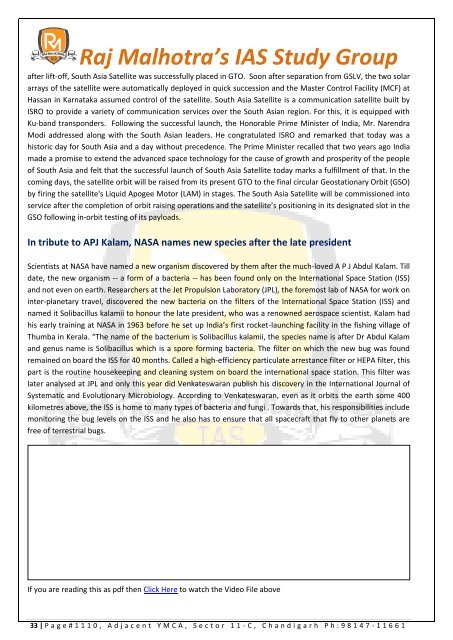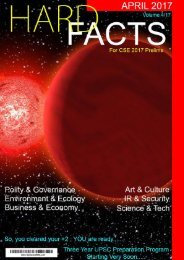Hard Facts 05 2017 (May)
You also want an ePaper? Increase the reach of your titles
YUMPU automatically turns print PDFs into web optimized ePapers that Google loves.
Raj Malhotra’s IAS Study Group<br />
after lift-off, South Asia Satellite was successfully placed in GTO. Soon after separation from GSLV, the two solar<br />
arrays of the satellite were automatically deployed in quick succession and the Master Control Facility (MCF) at<br />
Hassan in Karnataka assumed control of the satellite. South Asia Satellite is a communication satellite built by<br />
ISRO to provide a variety of communication services over the South Asian region. For this, it is equipped with<br />
Ku-band transponders. Following the successful launch, the Honorable Prime Minister of India, Mr. Narendra<br />
Modi addressed along with the South Asian leaders. He congratulated ISRO and remarked that today was a<br />
historic day for South Asia and a day without precedence. The Prime Minister recalled that two years ago India<br />
made a promise to extend the advanced space technology for the cause of growth and prosperity of the people<br />
of South Asia and felt that the successful launch of South Asia Satellite today marks a fulfillment of that. In the<br />
coming days, the satellite orbit will be raised from its present GTO to the final circular Geostationary Orbit (GSO)<br />
by firing the satellite's Liquid Apogee Motor (LAM) in stages. The South Asia Satellite will be commissioned into<br />
service after the completion of orbit raising operations and the satellite’s positioning in its designated slot in the<br />
GSO following in-orbit testing of its payloads.<br />
In tribute to APJ Kalam, NASA names new species after the late president<br />
Scientists at NASA have named a new organism discovered by them after the much-loved A P J Abdul Kalam. Till<br />
date, the new organism -- a form of a bacteria -- has been found only on the International Space Station (ISS)<br />
and not even on earth. Researchers at the Jet Propulsion Laboratory (JPL), the foremost lab of NASA for work on<br />
inter-planetary travel, discovered the new bacteria on the filters of the International Space Station (ISS) and<br />
named it Solibacillus kalamii to honour the late president, who was a renowned aerospace scientist. Kalam had<br />
his early training at NASA in 1963 before he set up India’s first rocket-launching facility in the fishing village of<br />
Thumba in Kerala. “The name of the bacterium is Solibacillus kalamii, the species name is after Dr Abdul Kalam<br />
and genus name is Solibacillus which is a spore forming bacteria. The filter on which the new bug was found<br />
remained on board the ISS for 40 months. Called a high-efficiency particulate arrestance filter or HEPA filter, this<br />
part is the routine housekeeping and cleaning system on board the international space station. This filter was<br />
later analysed at JPL and only this year did Venkateswaran publish his discovery in the International Journal of<br />
Systematic and Evolutionary Microbiology. According to Venkateswaran, even as it orbits the earth some 400<br />
kilometres above, the ISS is home to many types of bacteria and fungi . Towards that, his responsibilities include<br />
monitoring the bug levels on the ISS and he also has to ensure that all spacecraft that fly to other planets are<br />
free of terrestrial bugs.<br />
If you are reading this as pdf then Click Here to watch the Video File above<br />
33 | P a g e # 1 1 1 0 , A d j a c e n t Y M C A , S e c t o r 1 1 - C , C h a n d i g a r h P h : 9 8 1 4 7 - 1 1 6 6 1





